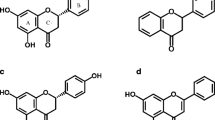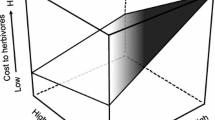Abstract
Theory predicts that mammalian herbivores detoxify different classes of plant secondary compounds via separate metabolic pathways and that generalist herbivores maintain broad diet breadth to avoid overloading individual detoxification pathways. We tested the hypothesis that a generalist marsupial herbivore, the common brushtail possum, Trichosurus vulpecula, can maintain a higher intake of food when allowed to select from two diets containing different profiles of secondary compounds (phenolics and terpenes) than when given access to the diets individually. Diets consisted of a fruit and vegetable mash to which was added ground leaves of either Eucalyptus melliodora or E. radiata. E. melliodora and E. radiata differ in their concentrations and types of secondary compounds. Brushtail possums include these eucalypt species as part of their natural diet. We measured food consumption and detoxification metabolites of possums on these diets. Consistent with the hypothesis, animals presented with a choice of both diets consumed more food than animals given diets singly. One of the two indicators of detoxification, acid load in urine, differed significantly between diets while the other, glucuronic acid, did not. These results provide partial support for the hypothesis that diet breadth is governed by detoxification abilities.
Similar content being viewed by others
REFERENCES
Adams, R. P., Zanoni, T. A., Rudloff, E. V., and Hogge, L. 1981. The southwestern USA and northern Mexico one-seeded junipers: Their volatile oils and evolution. Biochem. Syst. Ecol. 9:93-96.
Atsatt, S. R., and Ingram, T. 1983. Adaptation to oak and other fibrous, phenolic-rich foliage by a small mammal, Neotoma fuscipes. Oecologia 60:135-142.
Baudinette, R. V., Wheldrake, J. F., Hewitt, S., and Hawke, D. 1980. The metabolism of [14C]phenol by native Australian rodents and marsupials. Aust. J. Zool. 28:511-520.
Blumenkrantz, N., and Asboe-Hansen, G. 1973. New method for quantitative determination of uronic acids. Anal. Biochem. 54:484-489.
Bryant, J. P., Wieland, G. D., Reichart, P. B., Lewis, V. E., and McCarthy, M. C. 1983. Pinosylvin methyl ether deters snowshoe hare feeding on green alder. Science 222:1023-1025.
Cameron, G. N., and Rainey, D. G. 1972. Habitat utilization by Neotoma lepida in the Mohave desert. J. Mammal. 53:251-266.
Clausen, T. P., Provenza, F. D., Burritt, E. A., Reichardt, P. B., and Bryant, J. P. 1990. Ecological implication of condensed tannin structure: A case study. J. Chem. Ecol. 16:2381-2392.
Dearing, M. D. 1996. Disparate determinants of winter and summer diet selection in a generalist herbivore, the North American pika, Ochotona princeps. Oecologia 108:467-478.
Dearing, M. D., and Schall, J. J. 1992. Testing models of diet assembly by the generalist herbivorous lizard, Cnemidophorus murinus. Ecology 73:845-867.
Dial, K. P. 1988. Three sympatric species of Neotoma: dietary specialization and coexistence. Oecologia 76:531-537.
Distel, R. A., and Provenza, F. D. 1991. Experience early in life affects voluntary intake of blackbrush by goats. J. Chem. Ecol. 17:431-450.
Dutton, G. J. 1980. Glucuronidation of Drugs and Other Compounds. CRC Press, Boca Raton, Florida.
Edwards, P. B., Wanjura, W. J., and Brown, W. V. 1993. Selective herbivory by Christmas beetles in response to intraspecific variation in Eucalyptus terpenoids. Oecologia 95:551-557.
Fitzgerald, A. E. 1978. Aspects of food and nutrition of the brush-tailed possum, Trichosurus vulpecula (Kerr 1972), Marsupialia: Phalangeridae in New Zealand, pp. 289-303, in G. G. Montgomery (ed.). The Ecology of Arboreal Folivores. Smithsonian Institution, Washington, D.C.
Foley, W. J. 1992. Nitrogen and energy retention and acid-base status in the common ringtail possum. Physiol. Zool. 65:403-421.
Foley, W. J., and Hume, I. D. 1987. Digestion and metabolism of high-tannin Eucalyptus foliage by the brushtail possum (Trichosurus vulpecula) (Marsupialia: Phalangeridae). J. Comp. Physiol. 157:67-76.
Foley, W. J., and McArthur, C. 1994. The effects and costs of allelochemicals for mammalian herbivores: An ecological perspective, pp. 370-391, in D. J. Chivers and P. Langer (ed.). The Digestive System in Mammals: Food, Form and Function. Cambridge University Press, Cambridge.
Foley, W. J., McLean, S., and Cork, S. J. 1995. Consequences of biotransformation of plant secondary metabolites on acid-base metabolism in mammals—a final common pathway? J. Chem. Ecol. 21:721-743.
Freeland, W. J. 1991. Plant secondary metabolites. Biochemical evolution with herbivores, pp. 61-82, in R. Palo and C. T. Robbins (eds.). Plant Defenses Against Mammalian Herbivory. CRC Press, Boca Raton, Florida.
Freeland, W. J., and Janzen, D. H. 1974. Strategies in herbivory by mammals: The role of plant secondary compounds. Am. Nat. 108:269-289.
Freeland, W. J., and Winter, J. W. 1975. Evolutionary consequences of eating: Trichosurus vulpecula (Marsupialia) and the genus Eucalyptus. J. Chem. Ecol. 1:439-455.
Ganzhorn, J. U. 1988. Food partitioning among Malagasy primates. Oecologia 75:436-450.
Goering, H. K., and Van Soest, P. J. 1970. Forage fiber analyses. Agricultural Handbook 39. USDA Washington, D.C.
Harmand, M. F., and Blanquet, P. 1978. The fate of flavanolic oligomers (OFT) extracted from Vitis vinifera L. in the rat. Eur. J. Drug. Metab. Pharmacokinet. 1:15-30.
Jakoby, W. B. 1980. Enzymatic Basis of Detoxication. Academic Press, New York.
Kerle, J. A. 1984. Variation in the ecology of Trichosurus: Its significance, pp. 115-128, in S. A. P. Hume and I. D. Hume (eds.). Possums and Gliders. Australian Mammal Society, Sydney.
McLean, S., Foley, W. J., Davies, N. W., Brandon, S., Duo, L., and Blackman, A. J. 1993. Metabolic fate of dietary terpenes from Eucalyptus radiata in common ringtail possum (Pseudocheirus peregrinus). J. Chem. Ecol. 19:1625-1643.
Porter, L. J., Hrstich, L. N., and Chan, B. C. 1986. The conversion of procyanidins and prodelphinidins to cyanidin and delphinidin. Phytochemistry 25:223-230.
Post, D. M., 1993. Detection of differences in nutrient concentrations by eastern woodrats (Neotoma floridana). J. Mammal. 74:493-497.
Reichardt, P. B., Bryant, J. P., Mattes, B. R., Clausen, T. P., Chapin, F. S., III, and Meyer, M. 1990. Winter chemical defense of Alaskan balsam poplar against snowshoe hares. Oecologia 16:1941-1959.
Sinclair, A. R. E., Madhu, K. J., and Andersen, R. J. 1988. Camphor from juvenile white spruce as an antifeedant for snowshoe hares. J. Chem. Ecol. 14:1505-1514.
Singleton, V. L., and Rossi, J. A. 1965. Colorimetry of total phenolics with phosphomolybdic phosphotungstic agents. Am. J. Enol. Vitic. 16:144-158.
Sipes, I. G., and Gandolfi, A. J. 1986. Biotransformation of toxicants, pp. 64-98, in C. D. Klaasen, M. O. Amdur, and J. Doull (eds.). Casarett and Doull's Toxicology, The Basic Science of Poisons. Macmillan, New York.
Southwell, I. A., Flynn, T. M., and Gegabriele, R. 1980. Metabolism of alpha-and beta-pinene and para-cymene and 1,8-cineole in the brushtail possum, Trichosurus vulpecula. Xenobiotica 10:17-23.
Testa, B., and Jenner, P., 1981. Inhibitors of the cytochrome P-450s and their mechanism of action. Drug Metab. Rev. 12:1-117.
Westoby, M. 1978. What are the biological bases of varied diets? Am. Nat. 112:627-631.
Author information
Authors and Affiliations
Rights and permissions
About this article
Cite this article
Dearing, M.D., Cork, S. Role of Detoxification of Plant Secondary Compounds on Diet Breadth in a Mammalian Herbivore, Trichosurus vulpecula . J Chem Ecol 25, 1205–1219 (1999). https://doi.org/10.1023/A:1020958221803
Issue Date:
DOI: https://doi.org/10.1023/A:1020958221803




